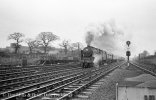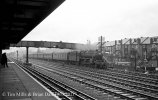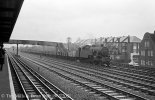Martin,
The Padd signal diagram is 1961 and I think pre any signalling and track rationalizations, though I may be wrong.
Brian, interesting shots, the first two are engine arriving for sure, the third is an ECS move but the Castle is not (appears not) doing any work, I suggest to relieve pathing that the train is being taken back by a shunting engine at the country end and the Castle is going for a free (path) ride back to OOC.
I'd like to know what train A22 is because despite arriving at Paddington, it still has a healthy load of coal, therefore my previous image of 7007 may not have been a light engine move, the lack of coal use is not a clear indication of an engines movement.
Did the GWR swap engines at Swindon, Didcot or Reading, I don't believe they did but I'm not a GWR acolyte so will take advice. The LNER changed engines at Doncaster and quite a lot at Grantham, LMR was Crewe unless it was a Liverpool, Manchester or Chester/Holyhead run.
Looking through GWRJ (the four main volumes are 73, 76, 78, 82 and there are probably more that I don't have concerning Paddington) the arrivals and departures are more distinct that I imagined, the June 54 timetable has all expresses arriving at platforms 8 through to 11, only three trains in 24 hrs arrive at Platform 7. Departures for the same date are all 1 to 4 with only 6 trains departing from platform 5.
Platforms 5-7 are predominately used for locals and parcels as are 14 and 15 with a few from 10, 11 and 12.
Back to OOC flyover, it was double track in 1926 and those tracks were UP (northern line) and DN (southern line) carriage, the DN carriage terminated at Westbourne park next to Portabello Jct SB. Only the UP carriage continues into Paddington and splits into two as seen on the previous diagram just West of Ranelagh Road.
Back even further to Brians photo that kicked all this off the running lines are thus.

1: UP Carriage/ECS via flyover.
2: DN Carriage from Westbourne Park via flyover, terminates at Westbourne Park.
3: Not named but joins 4 about 1/2 mile distant, could well be LE avoiding allowing light engines to run around stationary goods on line 4.
4: UP Goods which terminates in goods shed behind Royal Oak.
5: DN Goods and Carriage/ECS, this splits at Westbourne Park, DN goods goes to the goods depot behind Royal Oak, DN Carriage goes into Paddington.
So, we still know naff all, if the engine is coming off line 5 then it is a LE back to OOC, but if it is going forward it may take the LH switch at the single slip, run on the UP Goods (line 4) and then cross all lines at MP 1¾ to get to the UP Carriage. My gut feeling is that it's the first option and the engine is running back to OOC. I would expect LE to Paddington to take the LH pair of these lines and join line 3 or 4 which are both UP lines to Paddington.
The answer is for Brian to enlarge the single slip under the bridge, it the route is straight the engine is LE to OOC, if it is diverging then it maybe LE to Paddington.
I don't think the tracks changed names much if at all between 1926 and the above 1961 signalling diagram, certainly those lines on both diagrams do align and match.

 - throws another confusion in to the mix. I can't comment on whether the flyover line was single track or not. Certainly from the position of the footbridge it can be seen to be double track, but did it become single later on? I've also yet to find a photo (though memory is becoming somewhat confused now) of an ECS coming down the ramp to OOC. That may, of course, be due to Tim's wish to photograph the most dynamic pictures of locos working against the gradient but the lack of any photo at all of such a movement in itself seems a bit odd.
- throws another confusion in to the mix. I can't comment on whether the flyover line was single track or not. Certainly from the position of the footbridge it can be seen to be double track, but did it become single later on? I've also yet to find a photo (though memory is becoming somewhat confused now) of an ECS coming down the ramp to OOC. That may, of course, be due to Tim's wish to photograph the most dynamic pictures of locos working against the gradient but the lack of any photo at all of such a movement in itself seems a bit odd.






















